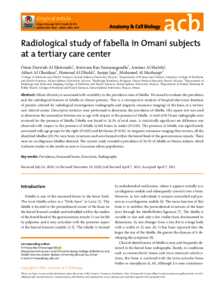Document
Radiological study of fabella in Omani subjects at a tertiary care center.
Identifier
DOI: 10.5115/acb.20.194
Source
Anatomy and Cell Biology. v. 54, 3, p. 315-320
Contributors
Sirasanagandla, Srinivasa Rao., Author
Al-Shabibi, Ammar., Author
Al-Obaidaniyah, Athari., Author
Al-Dhuhli, Humoud., Author
Jaju, Sanjay., Author
Al-Mushaiqri, Mohamed., Author
Country
Korea
City
Gwangju
Publisher
Korean Association of Anatomists.
Gregorian
2021-09-01
Language
English
Subject
English abstract
Ethnic diversity is associated with variability in the prevalence rates of fabella. We aimed to evaluate the prevalence and the radiological features of fabella in Omani patients. This is a retrospective analysis of hospital electronic database of patients referred for radiological investigations (radiographs and magnetic resonance imaging) of the knee, at a tertiary care referral center. Descriptive statistics were performed to determine the prevalence of fabella. Chi-square test was used to determine the association between sex or age with respect to the presence of fabella. A total of 813 knee radiographs were reviewed for the presence of fabella. Fabella was found in 24.1% of total cases. A statistically significant sex difference was observed with respect to the presence of fabella in left knees in males (P0.01). The presence of fabella was significantly associated with age groups for the right (P0.05) and left knees (P0.01). In magnetic resonance imaging film reviews, all the identified fabellae (20.2%) were bony structures and were located within the lateral head of the gastrocnemius muscle. There were no cartilaginous fabellae detected. The current study revealed a prevalence of 24.1% of fabella in Omani subjects which is almost similar to the results as seen in Caucasian ethnic populations.
ISSN
2093-3665
Category
Journal articles

